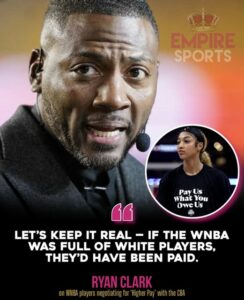The WNBA’s ongoing Collective Bargaining Agreement (CBA) negotiations have turned into one of the most heated conversations in professional sports. The core issue? Player compensation. But as former NFL star and ESPN analyst Ryan Clark made clear in a recent statement, the fight isn’t solely about money — it’s also about race, respect, and the recognition of women’s basketball as a premier sport.

A League of Exceptional Talent
Since its founding in 1996, the WNBA has showcased some of the most skilled athletes in the world. Players like A’ja Wilson, Breanna Stewart, Brittney Griner, and Angel Reese bring elite-level performances night after night. Yet, despite the league’s growing popularity, WNBA salaries still pale in comparison to their NBA counterparts — often by millions of dollars.
Ryan Clark’s comments cut straight to the heart of the matter. His assertion — that if the league were predominantly white, players would already be earning more — has sparked both outrage and support. For many, it’s a reflection of the intersection between gender and race in sports economics.
The Numbers Don’t Lie
In the 2024 season, the average WNBA salary hovered around $120,000, with the league’s top earners making just over $250,000. Contrast that with the NBA, where the average salary is over $10 million, and the league minimum exceeds $1 million. While revenue differences between the two leagues are often cited to justify this gap, critics argue that the WNBA’s limited media deals, smaller marketing budgets, and lower investment from ownership groups are part of a self-perpetuating cycle that undervalues women’s sports.
Beyond the Paycheck: The Racial Lens
Clark’s comments resonate in a broader social context. Roughly 80% of WNBA players are Black women — a demographic historically underpaid and undervalued in nearly every professional field, from entertainment to corporate leadership. Advocates say this isn’t just about equal pay for women’s basketball — it’s about dismantling systemic inequalities that influence how the league is marketed, funded, and celebrated.
Angel Reese, who has quickly become one of the most marketable faces in the WNBA, recently wore a shirt reading, “Pay Us What You Owe Us,” during pregame warmups. Her message aligns with Clark’s — the fight is as much about respect as it is about compensation.
The Economics of Visibility
One of the most glaring issues is media exposure. The NBA benefits from multi-billion-dollar TV contracts with ESPN, ABC, and TNT, while WNBA games often struggle for prime broadcast slots. More visibility equals higher advertising revenue, which in turn funds higher player salaries. Many believe that increased marketing investment could close the gap — not overnight, but significantly over time.
There are also sponsorship disparities. While some stars like Sabrina Ionescu and A’ja Wilson have secured high-profile endorsements, most WNBA players don’t receive the same brand recognition opportunities as male athletes. This further compounds income inequality and reduces their bargaining power in CBA negotiations.
The Road Ahead: What the New CBA Could Mean
As negotiations continue, players are pushing for:
-
Revenue Sharing: Similar to the NBA’s model, where players receive about 50% of basketball-related income.
-
Better Travel Accommodations: Including charter flights to improve player safety and performance.
-
Expanded Marketing Commitments: To raise the profile of the league and its stars.
-
Increased Salary Caps: To allow franchises to fairly compensate elite talent.
Clark’s words have added urgency to the talks, ensuring the conversation stays in the public eye. The question now is whether the WNBA and its ownership will see the value in investing more heavily in its players — not just as athletes, but as cultural icons capable of expanding the sport’s global reach.
Conclusion: More Than a Game
This moment in WNBA history is about far more than basketball. It’s about challenging the structures that have kept women’s sports underfunded and undervalued for decades. Whether through racial equity, fair compensation, or increased media visibility, the push for change is loud and growing.
If the league listens — and acts — the payoff could be monumental: not only in dollars, but in the lasting legacy of the women who fought for the respect they have always deserved.